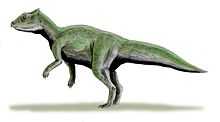Yinlong
| Yinlong Temporal range: Late Jurassic, 158Ma | |
|---|---|
 | |
| Fossil skull | |
| Scientific classification | |
| Kingdom: | Animalia |
| Phylum: | Chordata |
| Clade: | Dinosauria |
| Order: | †Ornithischia |
| Clade: | †Marginocephalia |
| Suborder: | †Ceratopsia |
| Genus: | †Yinlong Xu et al., 2006 |
| Species: | † Y. downsi |
| Binomial name | |
| Yinlong downsi Xu et al., 2006 | |
Yinlong (meaning "hidden dragon") is a genus of basal ceratopsian dinosaur from the Late Jurassic Period of central Asia. It was a small, primarily bipedal herbivore, approximately 3 meters (9.8 ft) long.[1] Yinlong is the oldest and most primitive ceratopsian known to science.
Discovery and species

A coalition of American and Chinese paleontologists, including Xu Xing, Catherine Forster, Jim Clark, and Mo Jinyou, described and named Yinlong in 2006. The generic name is derived from the Mandarin Chinese words 隱 (yǐn: "hidden") and 龍 (lóng: "dragon"), a reference to the movie Crouching Tiger, Hidden Dragon, large portions of which were filmed in the western Chinese province of Xinjiang, near the locality where this animal's fossil remains were discovered. Long is the word most often used in the Chinese media when referring to dinosaurs.
Yinlong species
- Y. downsi (type)
The species was named after the late William Randal Downs III, a frequent participant in paleontological expeditions to China, who died the year before Yinlong was discovered.
The known fossil material of Yinlong consists of many skeletons and skulls.[1] The first specimen discovered was a single exceptionally well-preserved skeleton, complete with skull, of a nearly adult animal, found in 2004 in the Middle-Late Jurassic strata of the Shishugou Formation located in Xinjiang Province, China. Yinlong was discovered in an upper section of this formation which dates to the Oxfordian stage of the Late Jurassic, or 161.2 to 155.7 million years ago.[1] All other described ceratopsians are known from the later Cretaceous Period.
Classification
A small rostral bone on the end of the upper jaw clearly identifies Yinlong as a ceratopsian, although the skull displays several features, especially the ornamentation of the squamosal bone of the skull roof, which were previously thought to be unique to pachycephalosaurians. The presence of these features in Yinlong indicates these as actual synapomorphies (unique features) of the larger group Marginocephalia, which contains both the pachycephalosaurs and the ceratopsians, although these features have been lost in all known ceratopsians more derived than Yinlong. The addition of these characters further strengthens the support for Marginocephalia. Yinlong also preserves skull features reminiscent of the family Heterodontosauridae, providing support for the hypothesis that heterodontosaurids are closely related to marginocephalians (Cooper, 1985; Zhao et al., 1999; You et al., 2003). The group containing Marginocephalia and Heterodontosauridae has been named Heterodontosauriformes (Xu et al., 2006).
Diet
Yinlong was discovered with seven gastroliths preserved in the abdominal cavity. Gastroliths, stones stored in the digestive tract and used to grind plant material, are also found in other ceratopsians such as Psittacosaurus, and are also widely distributed in most other dinosaur groups, as well as in many types of birds.
In popular culture
Yinlong made its first appearance in popular culture on the National Geographic Channel documentary "Dino Death Trap" as a prey item of Guanlong. The documentary called Yinlong "a little ancestor of the giant dinosaurs like Triceratops", while contrasting the shape of Yinlong's head to those of the later ceratopsian. The documentary highlighted the importance of the find, and stated that the fossil remains "give a snap-shot of dinosaur evolution".[2]
References
- ↑ 1.0 1.1 1.2 Holtz, Thomas R. Jr. (2011) Dinosaurs: The Most Complete, Up-to-Date Encyclopedia for Dinosaur Lovers of All Ages, Winter 2010 Appendix.
- ↑ "Dino Death Trap (National Geographic)". 2007-12-09. http://www.youtube.com/watch?v=cn25SkgKgtU&feature=related.
- Cooper, M.R. 1985. "A revision of the ornithischian dinosaur Kangnasaurus coetzeei Haughton, with a classification of the Ornithischia." Annals of the South African Museum 95: 281-317.
- Xu, X., Forster, C.A., Clark, J.M., and Mo, J. (2006). "A basal ceratopsian with transitional features from the Late Jurassic of northwestern China." Proceedings of the Royal Society B: Biological Sciences, 273(1598): 2135-2140. doi:10.1098/rspb.2006.3566
- You H., Xu X. & Wang X. 2003. "A new genus of Psittacosauridae (Dinosauria: Ornithopoda) and the origin and early evolution of marginocephalian dinosaurs." Acta Geologica Sinica (English edition) 77: 15–20.
- Zhao X., Cheng Z., & Xu X. 1999. "The earliest ceratopsian from the Tuchengzi Formation of Liaoning, China." Journal of Vertebrate Paleontology 19(4): 681-691.
External links
- GW News Center, featuring a link to the original paper, pictures, and a press release on the discovery of Yinlong (site operated by George Washington University)